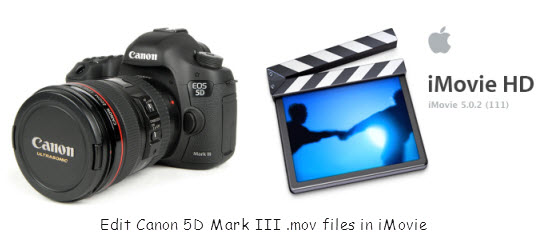If you’ve shot with a Canon SLR before, you’ll feel comfortable with the Mark III’s user experience. It’s not only the update of popular EOS 5D Mark II. There’s a couple of entirely new features too; the 5D Mark III becomes Canon’s first SLR capable of in-camera High Dynamic Range shooting, in an unusually well-implemented and flexible fashion, and gets expanded autobracketing options too (up to 7 frames covering a vast +/- 8 EV range). It can also record multiple exposures, if you so desire. It’s a great competitor to Nikon D800.

Canon EOS 5D Mark III record videos in MOV format, you may have tried to import the Canon 5D3 MOV footage into iMovie for editing. As we know, iMovie supports .mov files, but, you would find it took a long time for rendering. Actually, Apple’s editing software prefer their own professional codec. For example, Apple ProRes family is the most suitable for FCP 6/7 and latest FCP X editing, while Apple InterMediate Codec (AIC) is prefered by iMovie. These codec will keep the video quality lossless and when imported without rendering.
So as you see, though Apple InterMediate Codec is also mov format, but it’s different from Canon 5D Mark III mov files. If you want to edit Canon 5D Mark III MOV videos in iMovie. I suggest you converting Canon 5D Mark III MOV to AIC for iMovie. Pavtube video converter for Mac can help you. You may follow the steps to realize it.
Step 1. Download and install this Mac MOV to AIC converter on your computer. Run it, add your mov files into this program.
Step 2. Choose Apple InterMediate Codec as output. Click on “Format” box, choose ” iMovie and Final Cut Express -> Apple InterMediate Codec(AIC) (*.mov)”.

Step 3. Start transcoding Canon 5D Mark III MOV to Apple Intermediate Codec (AIC) format for iMovie by clicking on the big “Convert” button.
Once the conversion completed, click the “Open” button to find the converted video file, then, you are able to transfer Canon 5D Mark III MOV clips to iMovie for editing without rendering.
Related posts:
- Import AVCHD or MOD footage into iMovie for advanced editing
- Import Canon XF 100 footage ( .MXF files ) to Final Cut Pro X smoothly
- Convert Canon C300 clips ( .mxf files ) to Apple ProRes for editing in Final Cut Pro
- How to Convert H.264 to ProRes for Editing on Final Cut Pro (FCP)
- Convert DVD to Apple ProRes Family for Editing in FCP 6/7 – Mac DVD to ProRes Converter

Recent Comments